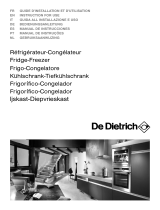7
INSTALLATION
•Be careful not to damage the floors (e.g. parquet)
when moving the appliance.
• Make sure the appliance is not near a heat source.
• Install and level the appliance on a floor strong
enough to take its weight and in a place suitable for
its size and use.
• The appliance is arranged for operation in places
where the temperature comes within the following
ranges, according to the climatic class given on the
rating plate. The appliance may not work properly
if it is left for a long time at a temperature outside
the specified range.
•Make sure the voltage specified on the rating plate
corresponds to that of your home.
SAFE USE
•Do not store or use petrol, flammable liquids or gas
in the vicinity of this or other electrical appliances.
The fumes can cause fires or explosions.
• Do not swallow the contents (non-toxic) of the
ice packs (in some models).
• Do not eat ice cubes or ice lollies immediately
after taking them out of the freezer since they may
cause cold burns.
• For products designed to use an air filter inside an
accessible fan cover, the filter shall be always in
position when the refrigerator is in function.
• Before carrying out any maintenance or cleaning
operation, unplug the appliance or disconnect it
from the power supply.
• Use the refrigerator compartment only for storing
fresh food and the freezer compartment only for
storing frozen food, freezing fresh food and making
ice cubes.
• Do not store glass containers with liquids in the
freezer compartment since they may break.
• Avoid storing unwrapped food in direct contact
with internal surfaces of the refrigerator or freezer
compartments.
• “The bulb used inside the appliance is specifically
designed for domestic appliances and is not suitable
for general room lighting within the home (EC
Regulation 244/2009)”.
The Manufacturer declines any liability for
injury to persons or animals or damage to
property if the above advice and precautions
are not respected.
Climatic Class Amb. T. (°C)
SN From 10 to 32
N From 16 to 32
ST From 16 to 38
T From 16 to 43
Precautions and general recommendations
•
Install the appliance in a dry, well ventilated room
far away from any heat source (e.g. radiator,
cooker, etc.) and in a place not exposed directly
to the sun. If required, use an insulating plate.
• To guarantee adequate ventilation follow
installation instructions.
• Insufficient ventilation on back of the product
increases energy consumption and decreases
cooling efficiency.
• The internal temperatures of the appliance may
be affected by the ambient temperature,
frequency of door opening, as well as location of
the appliance. Temperature setting should take
into consideration these factors.
• Allow warm food and drinks to cool down
before placing in the appliance.
• Do not obstruct the fan (if available) with food
items.
• After placing the food check if the door of
compartments closes properly, especially the
freezer door.
• Reduce to a minimum door opening.
• When thawing frozen food, place them in the
refrigerator. The low temperature of the frozen
products cools the food in the refrigerator.
• Appliances could have special compartments
(Fresh Food Compartment, Zero Degree Box,...).
In case not differently specified in the specific
booklet of product, they can be removed,
maintaining equivalent performances.
• Positioning of the shelves in the refrigerator has
no impact on the efficient usage of energy. Food
should be placed on the shelves in such way to
ensure proper air circulation (food should not
touch each other and distance between food and
rear wall should be kept).
• You can increase storage capacity of frozen food
by removing baskets and, if present, Stop Frost
shelve, maintaining an equivalent energy
consumption.
• Damaged gasket must be replaced as soon as
possible.
• High energy class products are fitted with
highefficiency motors that remain operational for
longer, but have a low power consumption. Do
not worry if the engine continues to run for
longer periods.
Energy-saving tips
















